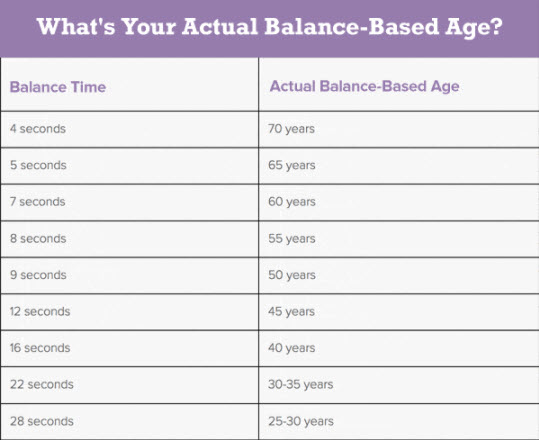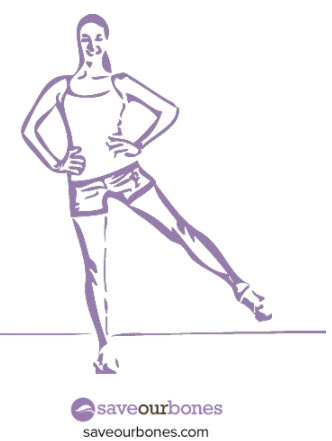By Vivian Goldschmidt, MA
How’s Your Balance? Take This 30-Second Test To Find Out 
Today you’ll discover a simple test so you can determine whether your balance is in top shape or if you need to take action to improve it. In addition, you’ll also get an easy yet effective exercise that you can practice anytime anywhere to enhance your balance.
Let’s begin by exploring this very important topic…
What’s Involved In Maintaining Balance?
Without your having to think about it, your body does an astonishing balancing act every day. And I am not just talking about your busy schedule! For you to stay up on two feet, a delicate interplay occurs between your eyes, ears, brain, and muscles.
Visual cues from our eyes give us information about where we are in space. This is why it can be difficult to keep your balance with your eyes closed. Your eyes also send signals to your brain, telling your joints and muscles where and how to move. For example, if you see an obstacle in your path, this visual cue will be sent to your brain which will then signal your muscles to walk around or over the object.
Your inner ear is also involved in the balancing process. Among its tiny, delicate mechanisms is the semi-circular canal. This fluid-filled tube alerts your central nervous system as to the position of your head.
You also have a built-in mechanism that tells your nervous system where your arms and legs are in space. It’s called internal spatial orientation, and it’s the automatic sense that lets you know your arm is out to the side or your leg is pointing forward (for example).
Now let’s move on so you can find out if your balance is up to par.
The 30-Second Balance Test
First, you’ll need to find a partner to time you, because your eyes will be closed. It’s also important to have someone close by in case you fall.
- Stand barefoot on a hard floor. Now close your eyes.
- Bend one knee and lift the foot – if you’re left-handed, stand on your left leg and lift the right foot; do the opposite if you’re right-handed. You don’t need to lift it high; even though your eyes are closed, you can probably estimate about 6 inches off the floor.
- Ask the person with you to check his or her watch, and time how long you can hold that position without wobbling or opening your eyes.
(For example, if test 1 was 4 seconds, test 2 was 8 seconds, and test 3 was 6 seconds, you’d add up 4, 8, and 6 to get 18. Divide by 3, and your average balance time is 6 seconds.)

Not surprisingly, the chart shows that the number of seconds decreases with age. In the 25-30 year group, for example, the average eyes-closed balance time is 28 seconds. For 50-year-olds, it’s 9 seconds; 65-year-olds average 5 seconds, and 70-year-olds 4 seconds.
That’s because…
Balance Tends To Decrease With Age
As we get older, our eyesight tends to diminish, throwing a wrench in the first step in good balance (vision). Muscles tend to shrink and your reaction time may be a bit slower. But there’s good news, because…
You Can Improve Your Balance Regardless Of Age
You don’t have to be resigned to poorer balance as you age. You can take action to improve and maintain it.
You know how important balance is, and many of you are probably already doing the “Flamingo trick,” which involves standing on one leg while doing an every day chore.
A Recent Study Confirms What We Have Known For Years!
A study published last year shows that there’s scientific validity to the Flamingo trick, but you already knew that! Researchers conducted a trial to study the effectiveness of the “dynamic flamingo exercise” in preventing falls. They found that periodically standing on one leg does in fact improve balance, prevent falls, and even improve independent living.1
Once again, something very simple can have a big impact.
In a meta-analysis review of 17 trials involving a total of 4305 participants aged 60 and older, researchers concluded that regularly engaging in balance exercises not only prevented falls, but actually prevented injury (including fractures) when falls did occur. Even in the case of severe falls, injuries were less common among those who exercised regularly.2
Improve Your Balance With Bone-Healthy Nutrition And Exercise
The research is clear: regular balance exercises prevent falls and fractures.
Additionally, certain foods also promote balance. Foods rich in a substance called resveratrol actually prevent neural cell death and markedly improve balance and coordination. Red grapes, blueberries, cranberries, and peanuts are rich in resveratrol.
A good place to get started with balancing exercises is with this simple move you can do just about anywhere.
The Side Leg Lift

- Begin by standing near a wall or chair so you can catch yourself if necessary. Wear comfortable shoes, and stand with knees slightly bent.
- Place both your hands on your waist.
- Gently lift one leg out to the side, just a few inches off the floor.
- Bring the leg back down to the starting position and repeat.
- Do a set of 10, then switch to the other leg and do a set of 10 on that side.
- Keep switching sides until you’ve done 3 sets of 10 on each side.
I suggest you practice balancing exercises for a few weeks, and then repeat the balance test.





Hi there
Thank you for your email. Do you have any recommendations or perhaps experience with the Densercise and/or Osteoporosis Reversal Program?
I was recently diagnoses with osteoporosis after a bone density scan. The GP offered me Alendronate … which I kindly declined!
Look forward to hearing from you.
Thank you
Kind regards
Ingrid
i will try harder. i am 77 and achieved 4
Excellent exercise on the balance test. Will do this regularly and introduce to others.
Practice will make the world of difference!
This article is written by the researcher and we have not had personal experience of the programmes mentioned. It looked valid and interesting which is why we brought it to readers’ attention. Well worth your further research.
Yes, support these exercises. All Ryman HealthVillages run 45 minute exercise classes Mon Wed Fri with an instructor which focuses on these balancing, cardio and also strength exercises for residents.
Such an important activity! Well done!
This is going to be great. Have just tried it but the wobbling was awful!!! I am 92 and am going to get this done properly and well. I think bare feet might be an idea and will try it. Really looking forward to it. Your ideas and lessons are wonderful. Thank you so much.
I’m 73 and right handed. Interesting that balancing on my “off” foot, the left one, produces 4 x the score than on my right foot. Do others get the same result? If so, it suggests that balance is naturally better on the opposite foot to your dominant hand. I wonder why.
Hello David. Here’s an explanation of your interesting question: The two hemispheres of the brain control two different parts of the body because the nerves that travel down from the brain to the periphery (hands for example) cross over at the medulla. This means on the Left hemisphere of the brain in the motor cortex the nerves will travel down ipsilaterally (same side) UNTIL they reach the medulla. At that point they cross over so the original left hemisphere axons will be on the right side of the body (contralaterally). They continue on this other side to the spinal cord where they will send the message further to the target. This nerve pathway is called the lateral corticospinal tract.
Hope this helps!
Thank you, Heather – and well done on continuing to do everything you can to maintain your healthy brain. You are a splendid role model!
See also the interesting article Maureen has posted about the dominant leg.
love the “Balancing Act”my body responds well gives me a positive mental stimulant as well my kittens think I”m crazy!!! Kia Kaha Shirley
Thanks for your response, Gillian. I understand what you say, but don’t understand why the feet are controlled by a different part of the brain to the hands. Surely they are both “peripheral” parts of the body?
Sorry, David, I wasn’t very clear in my earlier response – the hands were just an example of the parts of the body on that side. Here’s another quotation from a neurosurgeon:
Research has determined that touching one side of the brain sends electrical signals to the other side of the body. Touching the motor region on the right side of the brain would cause the opposite side or the left side of the body to move. Stimulating the left primary motor cortex would cause the right side of the body to move. The messages for movement and sensation cross to the other side of the brain and cause the opposite limb to move or feel a sensation. The right side of the brain controls the left side of the body and vice versa. So if a brain tumor occurs on the right side of the brain that controls the movement of the arm, the left arm may be weak or paralyzed.
https://www.aans.org/Patients/Neurosurgical-Conditions-and-Treatments/Anatomy-of-the-Brain
Would it be true to suggest that the flamingo trick might strengthen the other exercise of just simply lifting your leg and holding that position without closing eyes. I can do that for sometime.
I also do the flamingo trick (which I can hold for a while) and when I start wobbling, without touching the floor with the elevated leg, I snap my eyes open and continue the process with my eyes open for a while then repeat.
Yes, Mary – both ways of exercising like this are helping. Your corpus callosum is activated (the part of the brain coordinating the two hemispheres in your brain. It is a thick bundle of nerve fibres that ensures both sides of the brain can communicate and send signals to each other.) Keep up the practice!
Very important to practise balance exercise as we get older. I volunteer as a hospital friend and in our small hospital a large percentage of admissions are 70plus with falls.
I find the Nymbl Ap by physios very good also .
Enjoyed the new newsletter , informative, thankyou.
Thanks so much for your message Robyn. We will have to check out the Nymbl App you have mentioned.
I little bit, done regularly can make a huge difference when it comes to Balance.
I had vertigo, it was troubling but has now almost resolved. I put it down to cycling.
I suffered from vertigo; what seems to have helped is cycling the Trails in the South Island.
And home.
Gives my balance equipment a work out